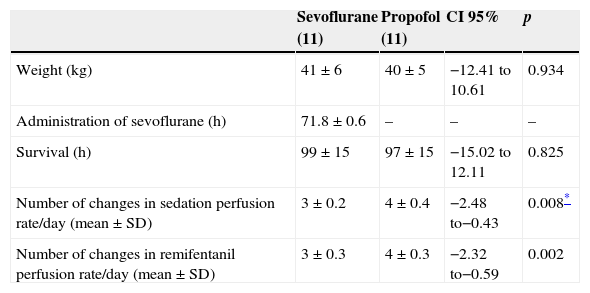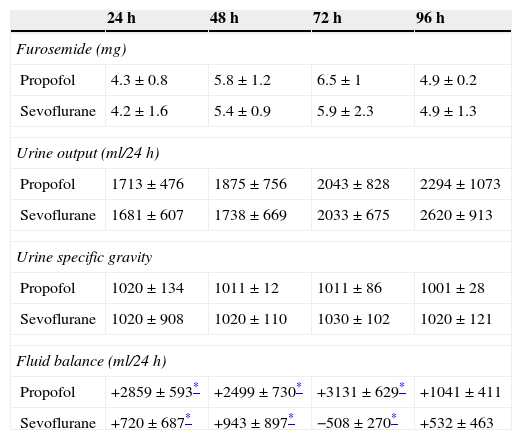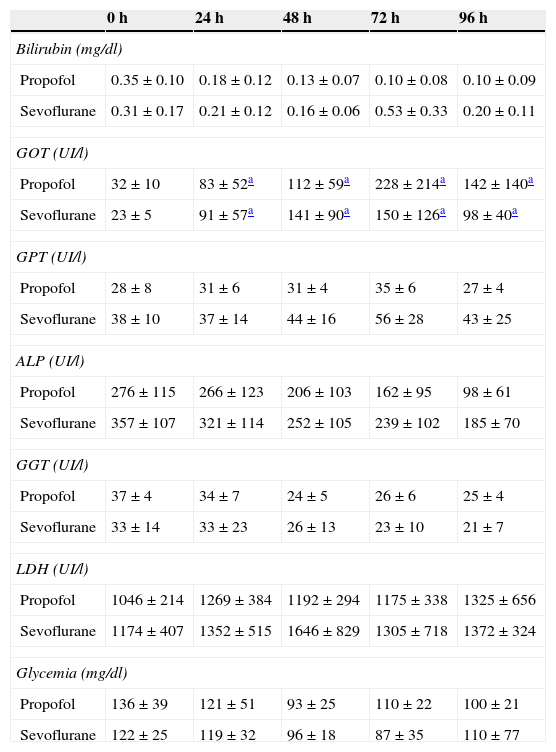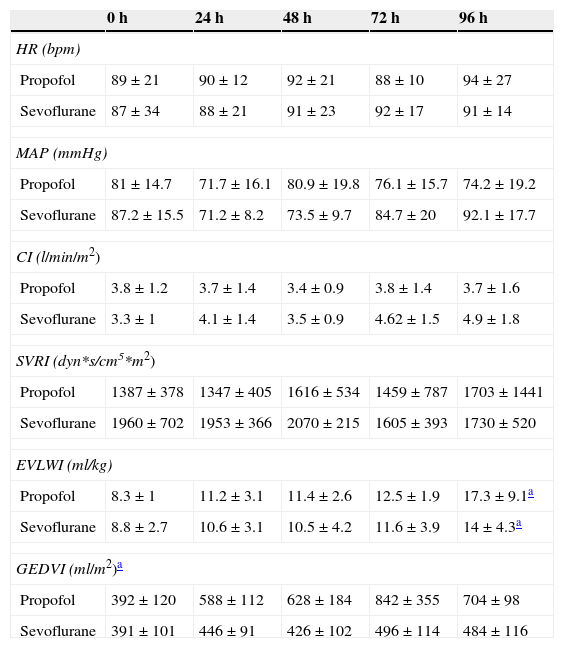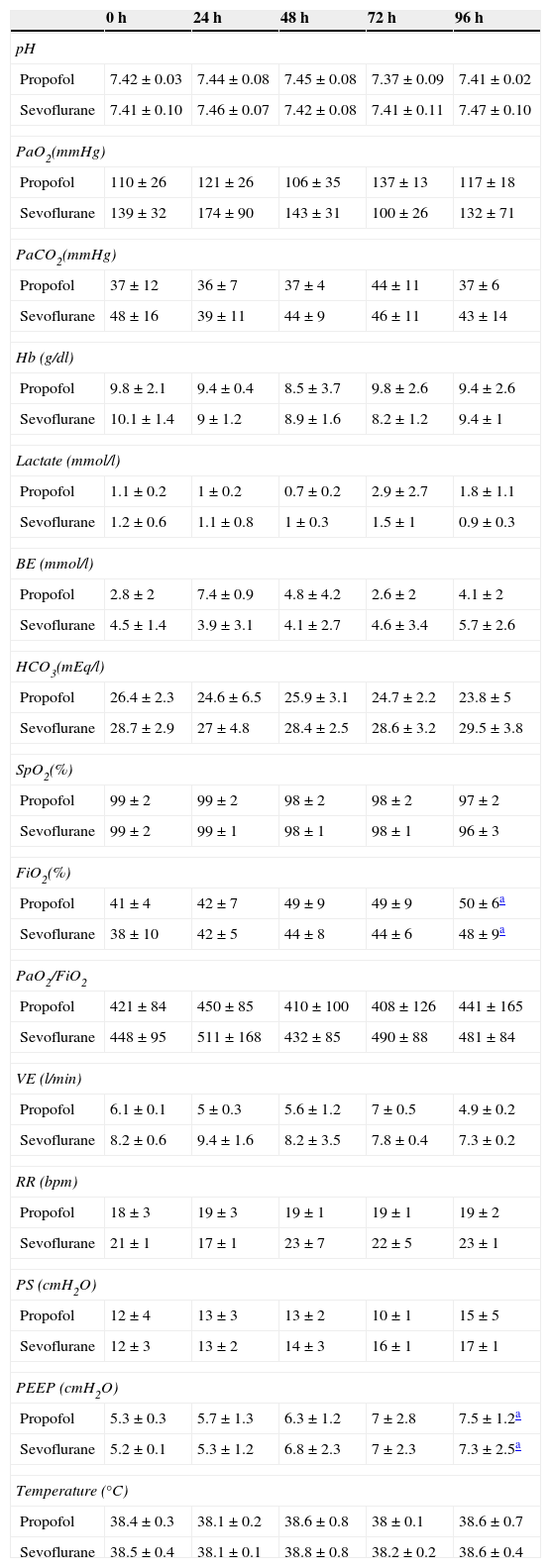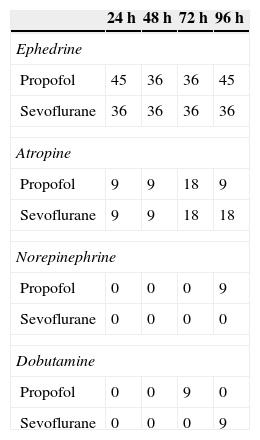Critically ill patients are sedated with intravenous agents because the use of inhaled agents is limited by their potential risk of toxicity. Increasing levels of inorganic fluorides after the metabolism of these agents have been considered potentially nephrotoxic. However, hepatic involvement after prolonged administration of sevoflurane has not yet been studied. The present study evaluated the potential renal and hepatic toxicity caused by prolonged administration (72h) of sevoflurane.
MethodsFor this experimental, prospective, randomized, controlled trial, 22 Landrace×Large-White female pigs were randomly assigned to two groups: intravenous propofol (P) or inhaled sevoflurane via the AnaConDa™ device (S, end-tidal 2.5vol%). The P group remained sedated for 108h with propofol. In the S group, sevoflurane was administered for 72h and then changed to propofol for the remaining 36h in order to observe the kinetics of fluoride after discontinuation of sevoflurane. Serum creatinine was the primary outcome variable, but inorganic fluoride concentrations and other renal, hepatic, and cardiorespiratory variables were also measured.
ResultsBoth groups of animals were comparable at baseline. No differences were found between the two groups for plasma creatinine and urea or creatinine clearance throughout the study. Fluoride levels were significantly higher in the sevoflurane group. No correlation was found between inorganic fluoride and serum creatinine values. No significant differences were observed for hepatic function. Hemodynamic, respiratory, and blood gas variables were comparable between the groups.
ConclusionsLong-term sedation with sevoflurane using AnaConDa™ or propofol does not negatively affect renal or hepatic function.
En la actualidad la sedación de los pacientes críticos se realiza mediante agentes intravenosos. La utilización de agentes inhalatorios, como alternativa a la sedación intravenosa, se encuentra limitada por su potencial riesgo de toxicidad. El incremento de los niveles de fluoruros inorgánicos, tras su metabolización, ha sido considerado potencialmente nefrotóxico. Por otro lado, la afectación hepática después de la administración prolongada de sevoflurano no ha sido estudiada. Se evaluó la potencial toxicidad renal y hepática causada por la administración prolongada (72h) de sevoflurano.
MétodosEstudio experimental, prospectivo, aleatorizado y controlado. Veintidós animales cerdas de la raza Landrace×Large-White fueron asignadas aleatoriamente a 2 grupos en función del régimen de sedación administrado (P: propofol por vía intravenosa; o S: sevoflurano inhalado a través del sistema AnaConDa®, end-tidal 2,5%). El grupo P se mantuvo sedado durante 108h con propofol. Al grupo S se le administró sevoflurano durante 72h, cambiando a propofol durante las 36h restantes, con el objetivo de observar la cinética de los fluoruros plasmáticos tras la interrupción del sevoflurano. Se midieron la creatinina plasmática como variable principal, las concentraciones de fluoruros inorgánicos y otras variables de función renal, hepática y cardiorrespiratoria.
ResultadosAmbos grupos de animales fueron comparables en el momento basal. No hubo diferencias significativas entre ambos grupos en cuanto a los valores de creatinina plasmática, urea y aclaramiento de creatinina. Los niveles de fluoruros fueron significativamente mayores en el grupo de sevoflurano. No encontramos una correlación entre las cifras de fluoruros inorgánicos y los valores de creatinina plasmática. Tampoco se observaron diferencias significativas en los parámetros de función hepática. Las variables hemodinámicas, respiratorias y gasométricas fueron comparables entre los grupos.
ConclusionesLa sedación de larga duración no afecta a la función renal ni hepática, independientemente del agente utilizado.










